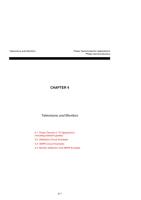Power Semiconductor Applications
Philips Semiconductors
Preface
This book was prepared by the Power Semiconductor Applications Laboratory of the Philips Semiconductors product
division, Hazel Grove. The book is intended as a guide to using power semiconductors both efficiently and reliably in power
conversion applications. It is made up of eight main chapters each of which contains a number of application notes aimed
at making it easier to select and use power semiconductors.
CHAPTER 1 forms an introduction to power semiconductors concentrating particularly on the two major power transistor
technologies, Power MOSFETs and High Voltage Bipolar Transistors.
CHAPTER 2 is devoted to Switched Mode Power Supplies. It begins with a basic description of the most commonly used
topologies and discusses the major issues surrounding the use of power semiconductors including rectifiers. Specific
design examples are given as well as a look at designing the magnetic components. The end of this chapter describes
resonant power supply technology.
CHAPTER 3 describes motion control in terms of ac, dc and stepper motor operation and control. This chapter looks only
at transistor controls, phase control using thyristors and triacs is discussed separately in chapter 6.
CHAPTER 4 looks at television and monitor applications. A description of the operation of horizontal deflection circuits is
given followed by transistor selection guides for both deflection and power supply applications. Deflection and power supply
circuit examples are also given based on circuits designed by the Product Concept and Application Laboratories (Eindhoven).
CHAPTER 5 concentrates on automotive electronics looking in detail at the requirements for the electronic switches taking
into consideration the harsh environment in which they must operate.
CHAPTER 6 reviews thyristor and triac applications from the basics of device technology and operation to the simple design
rules which should be followed to achieve maximum reliability. Specific examples are given in this chapter for a number
of the common applications.
CHAPTER 7 looks at the thermal considerations for power semiconductors in terms of power dissipation and junction
temperature limits. Part of this chapter is devoted to worked examples showing how junction temperatures can be calculated
to ensure the limits are not exceeded. Heatsink requirements and designs are also discussed in the second half of this
chapter.
CHAPTER 8 is an introduction to the use of high voltage bipolar transistors in electronic lighting ballasts. Many of the
possible topologies are described.

